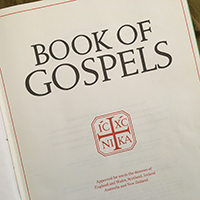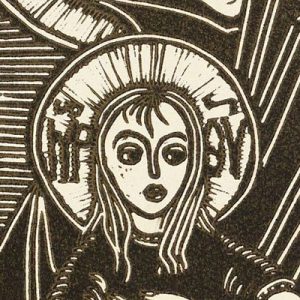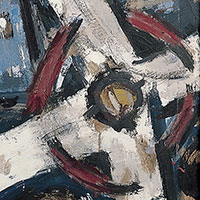 My name is Olga Bakhtina. Once in a while, people ask me why I paint Christian scenes. Every time the question comes up it surprises me. What does make a mostly self-taught contemporary artist like me paint Christian stories when so few people do? Continue reading “GOSPEL THEMES IN PAINT”
My name is Olga Bakhtina. Once in a while, people ask me why I paint Christian scenes. Every time the question comes up it surprises me. What does make a mostly self-taught contemporary artist like me paint Christian stories when so few people do? Continue reading “GOSPEL THEMES IN PAINT”
HOLY MYSTERIES
 Dr Rebekah Pryor is a visual artist and writer living and working on Boonwurrung/Bunurong Country southeast of Melbourne, Australia. She was a finalist in the 2018 Blake Prize and, from 2015-2018, the curator of Lamppost Gallery, a space dedicated to exploring contemporary art and Christian spirituality. She is an honorary postdoctoral associate at Pilgrim Theological College, University of Divinity. In 2021 she coedited Contemporary Feminist Theologies: Power, Authority, Love (Routledge) and her forthcoming book Motherly: Reimagining the Maternal Body in Feminist Theology and Contemporary Art is due for publication in early 2022. Continue reading “HOLY MYSTERIES”
Dr Rebekah Pryor is a visual artist and writer living and working on Boonwurrung/Bunurong Country southeast of Melbourne, Australia. She was a finalist in the 2018 Blake Prize and, from 2015-2018, the curator of Lamppost Gallery, a space dedicated to exploring contemporary art and Christian spirituality. She is an honorary postdoctoral associate at Pilgrim Theological College, University of Divinity. In 2021 she coedited Contemporary Feminist Theologies: Power, Authority, Love (Routledge) and her forthcoming book Motherly: Reimagining the Maternal Body in Feminist Theology and Contemporary Art is due for publication in early 2022. Continue reading “HOLY MYSTERIES”
ARTHUR BOYD AND SAINT FRANCIS OF ASSISI
 Arthur Boyd’s wife, Yvonne, commented that Arthur was very fond of Saint Francis. This was undoubtedly true and yet in his perceptive and idiosyncratic way our artist turns the medieval legend on its head. The saint’s values of human brotherhood, non-materialism and engagement with nature are preserved, while the proselytising and, in Boyd’s eyes, control over others is sternly rejected. The medieval Francis felt himself to be divinely inspired while Boyd in the 20th century was alone with his fragile yet dogged sense of his own humanity. Continue reading “ARTHUR BOYD AND SAINT FRANCIS OF ASSISI”
Arthur Boyd’s wife, Yvonne, commented that Arthur was very fond of Saint Francis. This was undoubtedly true and yet in his perceptive and idiosyncratic way our artist turns the medieval legend on its head. The saint’s values of human brotherhood, non-materialism and engagement with nature are preserved, while the proselytising and, in Boyd’s eyes, control over others is sternly rejected. The medieval Francis felt himself to be divinely inspired while Boyd in the 20th century was alone with his fragile yet dogged sense of his own humanity. Continue reading “ARTHUR BOYD AND SAINT FRANCIS OF ASSISI”
THE GIFT OF THE EPHEMERAL
 I acknowledge the Traditional Owners who have walked and cared for this land for thousands of years and their descendants who maintain these spiritual connections and traditions … Continue reading “THE GIFT OF THE EPHEMERAL”
I acknowledge the Traditional Owners who have walked and cared for this land for thousands of years and their descendants who maintain these spiritual connections and traditions … Continue reading “THE GIFT OF THE EPHEMERAL”
CLIFTON PUGH, LANDSCAPE and SUFFERING
 CLIFTON PUGH (1924-1990) was an Australian landscape and portrait painter. His engagement with the bush, however, stands in sharp contrast to the familiar landscapes of artists such as Arthur Streeton and Frederick McCubbin. Continue reading “CLIFTON PUGH, LANDSCAPE and SUFFERING”
CLIFTON PUGH (1924-1990) was an Australian landscape and portrait painter. His engagement with the bush, however, stands in sharp contrast to the familiar landscapes of artists such as Arthur Streeton and Frederick McCubbin. Continue reading “CLIFTON PUGH, LANDSCAPE and SUFFERING”
ABORIGINAL STATIONS OF THE CROSS
 This set of Stations of the Cross was commissioned by the Aboriginal Catholic Ministry of Victoria in 2017 and are arranged along the main wall of their chapel in Thornbury, Melbourne. They were imagined, dreamed and painted by John Dunn, an Olkola/Djabaguy man from Far North Queensland.
This set of Stations of the Cross was commissioned by the Aboriginal Catholic Ministry of Victoria in 2017 and are arranged along the main wall of their chapel in Thornbury, Melbourne. They were imagined, dreamed and painted by John Dunn, an Olkola/Djabaguy man from Far North Queensland.
A BOOK OF GOSPELS
 According to ancient tradition in the Church, the Book of Gospels is carried in the entrance procession at Mass, placed on the altar, and then ceremonially taken to the ambo for the proclamation of the Gospel. The Book of Gospels has always been given special respect and dignity in the Church because it is an icon of the presence of Christ to the liturgical assembly. Continue reading “A BOOK OF GOSPELS”
According to ancient tradition in the Church, the Book of Gospels is carried in the entrance procession at Mass, placed on the altar, and then ceremonially taken to the ambo for the proclamation of the Gospel. The Book of Gospels has always been given special respect and dignity in the Church because it is an icon of the presence of Christ to the liturgical assembly. Continue reading “A BOOK OF GOSPELS”
Natasha – a personal reflection

When first saw this piece in the early 90s, I was also exploring the Catholic faith. The imagery of an icon was immediately recognisable and arresting. The simplicity of rendering in apparent monotone and the animation of the child I found appealing. It represented for me a gentle welcome into a faith community that has since become my spiritual home. It also became a vehicle for a line of enquiry into my place in the Church and that of women in general. Continue reading “Natasha – a personal reflection”
ROGER KEMP, the CIRCLE and the SQUARE
 “His glimpses of the ineffable are translated to us in terms of dancing, for his paintings are a choreography of the spirit – but the dancing is never extravagant. It has the formal quality of a saraband. Every movement, every gesture, every brushstroke becomes part of a ritual.”
“His glimpses of the ineffable are translated to us in terms of dancing, for his paintings are a choreography of the spirit – but the dancing is never extravagant. It has the formal quality of a saraband. Every movement, every gesture, every brushstroke becomes part of a ritual.”
James Gleeson, review in Sydney’s Sun, 14 June 1967.
